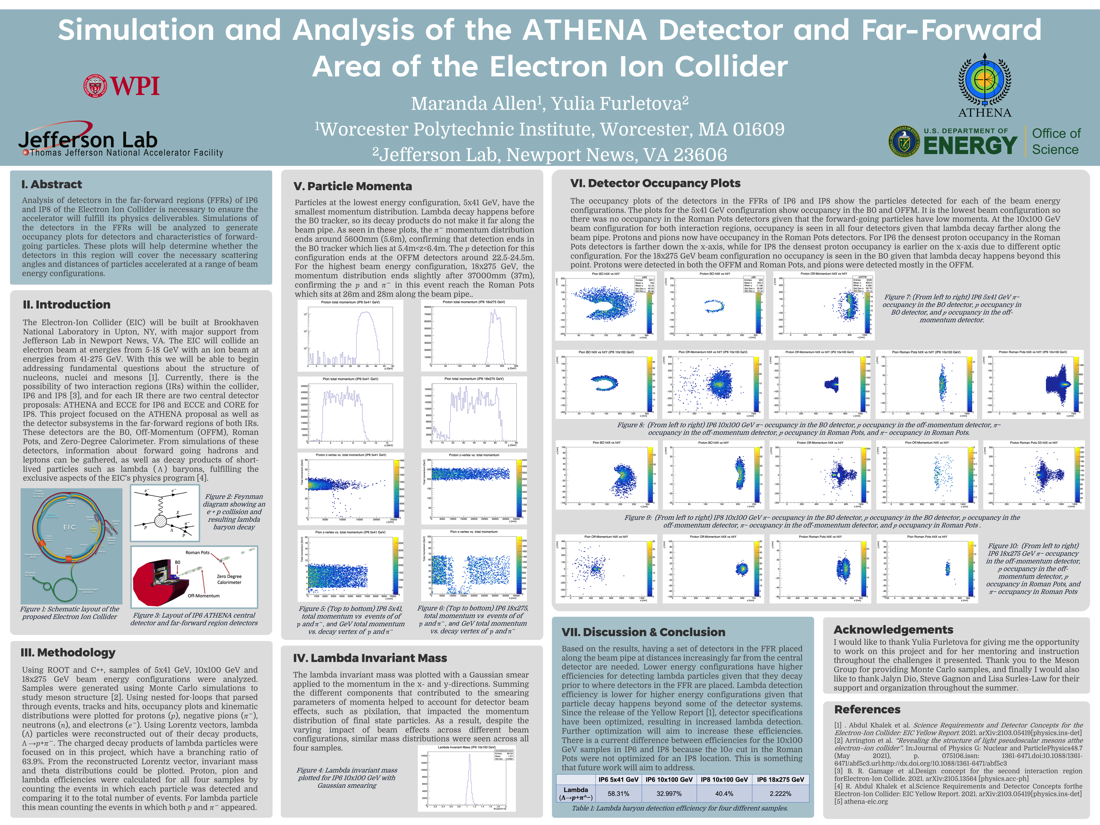Undergraduate Research at Jefferson Lab
Simulation and Analysis of the ATHENA Detector and Far-Forward Area of the Electron Ion Collider
Student: Maranda Allen
School: Worcester Polytechnic Institute
Mentored By: Dr. Yulia Furletova
The Electron Ion Collider (EIC) is a particle accelerator that will be built over the next decade at Brookhaven National Laboratory with Jefferson Lab providing major support. The EIC will collide an electron beam with an ion beam at two interactions regions, IP6 and IP8, at energy configurations of 5x41 GeV, 10x100 GeV and 18x275 GeV. In both interaction regions, there are two central detector proposals, and for this project the IP6 ATHENA proposal was focused on. Both IP6 and IP8 have a far-forward region (FFR) that contains a collection of detector subsystems: the B0, Off-Momentum and Roman Pots detectors and the Zero-Degree Calorimeter (ZDC). Each of these detector subsystems captures particles within a specific pseudorapidity to detect the forward-going particles. Using the information gathered from these detectors we will be able to further study the structure of hadrons, such as protons and pions. Additionally, using information from the decay products of lambda (λ) baryons, we can reconstruct and study these short-lived particles. Analyzing simulations of the detectors in the FFR will help prepare for detector proposal submissions and ensure that the EIC will fulfill its physics program. Samples generated from GEANT4 simulations of IP6 and IP8 were analyzed using ROOT and C++. Occupancy plots, momentum, vertex and theta distributions as well as information about lambda particles were generated for IP6 samples of 5x41 GeV, 10x100 GeV, and 18x275 GeV, and 10x100 GeV IP8 sample. To generate information about short-lived lambda particles, the particles were reconstructed using their decay products and Lorentz Vectors. The occupancy plots and distributions show what is successfully being captured by each detector for each energy configuration. As the energies increase, detectors farther along the beam pipe are still able to capture particles that miss closer detector systems. At lower energies, the acceptances of these forward-going particles are covered by the B0 and Off-Momentum detectors. From these results it becomes clear that a set of detector subsystems placed along the beam pipe at distances increasingly far from the central detector and covering a wide range of acceptances are needed. The data from the simulation and analysis of the FFRs of IP6 and IP8 help to prepare for the construction of the EIC and ensure that it will fulfill the physics requirements of the particle accelerator.
[Watch the presentation on YouTube]

Citation and linking information
For questions about this page, please contact Education Web Administrator.
